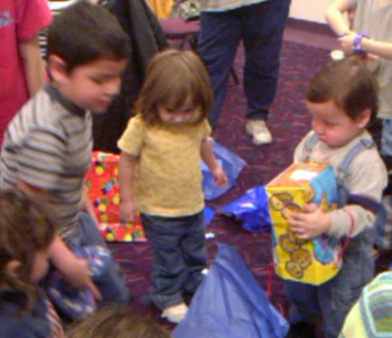 We all know children who will play with the box and wrapping paper a present came in rather than the toy itself. Why not? To a child, everything is a potential toy. Start thinking about what your child needs to learn next and you will find that your home is full of educational 'toys'.
We all know children who will play with the box and wrapping paper a present came in rather than the toy itself. Why not? To a child, everything is a potential toy. Start thinking about what your child needs to learn next and you will find that your home is full of educational 'toys'.
A friend who runs a community activity program told us this story,
"The kids are all running around the gym the first day. As they turn the corner, Billy keeps running straight and runs right into the wall. Instead of following the other kids, he just kept going in the direction he was going. "
Flashlight - Most children at a very young age learn how to 'visually track', that is, to focus on an object and follow that object with their eyes. Billy, due to his disability, had not acquired this skill. You can work on visual tracking with a child who is only a few months old, with older children who have limited movement due to severe disability, or with children such as Billy who simply failed to acquire this skill. Using any flashlight you have around the house, shine a light on the wall or ceiling directly in front of where your child is looking. Be sure to talk to your child while you are doing this. Every activity is a chance for you to teach your child more about language.
"Look! It's a light in front of you. See the light? Now it's moving. Watch. Here it goes. Slo-o-wly."
You can move the light slowly several times and then the next time move it quickly and say, "Fast!" really quickly. As your child is learning to visually track, she can also be learn about 'fast' and 'slow' and that sometimes things change in unexpected ways.
Cheerios - these are one of the best inventions ever for developmental stimulation. Don't believe me? Just try these two activities?
- For fine motor skills - spread out cheerios on your child's highchair tray, or on your table, if you don't have a high chair. Picking up the cheerios one by one and putting them in his mouth works fine motor skills, thumb and forefinger coordination, eye-hand coordination. Also, they are better for your child than Skittles or M&Ms and less sticky, too!
- Self-help skills - teach pouring by putting some Cheerios in a cup. Small paper or plastic cups are great for this because your child can grasp and lift these easily. Show your child how to pour from one cup into the next. This will make much less of a mess than using liquids, and if your child spills some, well, he can aways work on those fine motor skills picking them up.